We’ve found that successful bass ice fishing starts with understanding where they hide – largemouths near weed beds at 25 feet, smallmouths around rocky structures at 30 feet. Use short, sensitive rods with ice-specific line, and work tube jigs with a slow “pop and drop” technique. Fish early morning before 10 AM for best results, and transport gear efficiently with a dedicated sled. The right approach turns frigid days into memorable catches on the hardwater.
The Winter Behavior of Largemouth vs. Smallmouth Bass
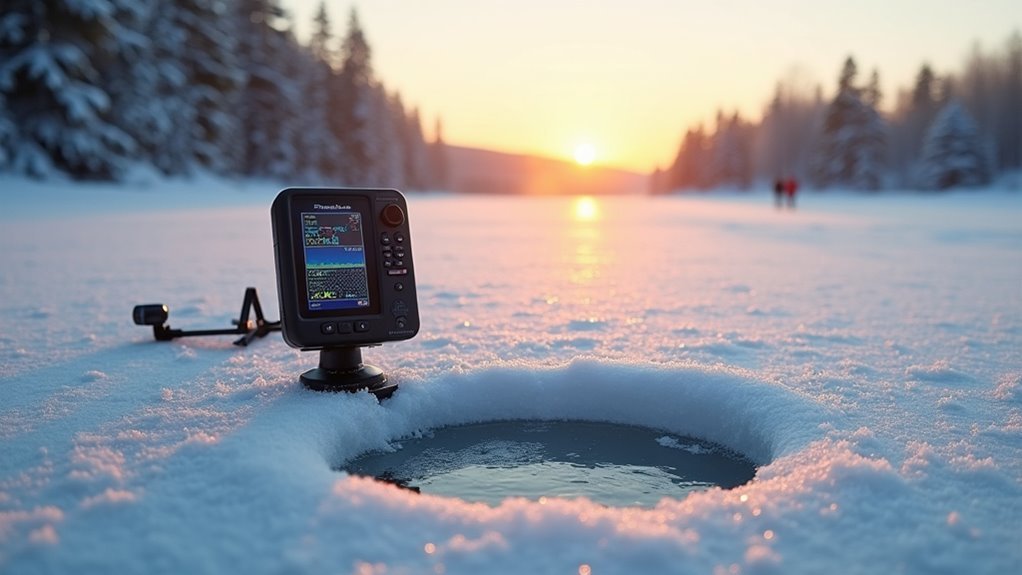
While winter transforms our favorite fishing spots into frozen wonderlands, bass don’t simply disappear – they dramatically change their behavior.
Largemouth bass prefer shallow, weedy areas under 30 feet deep, while smallmouths hang around rocky bottoms down to 40 feet. When the sun warms things up a bit, they’ll both venture into shallower water to hunt minnows and shad. I’ve had my best luck targeting largemouths near weed beds at about 25 feet deep. Smallmouths are trickier – they retreat to around 30 feet when it’s cold, hugging rock piles and stumps like their lives depend on it.
Essential Ice Fishing Gear for Targeting Bass
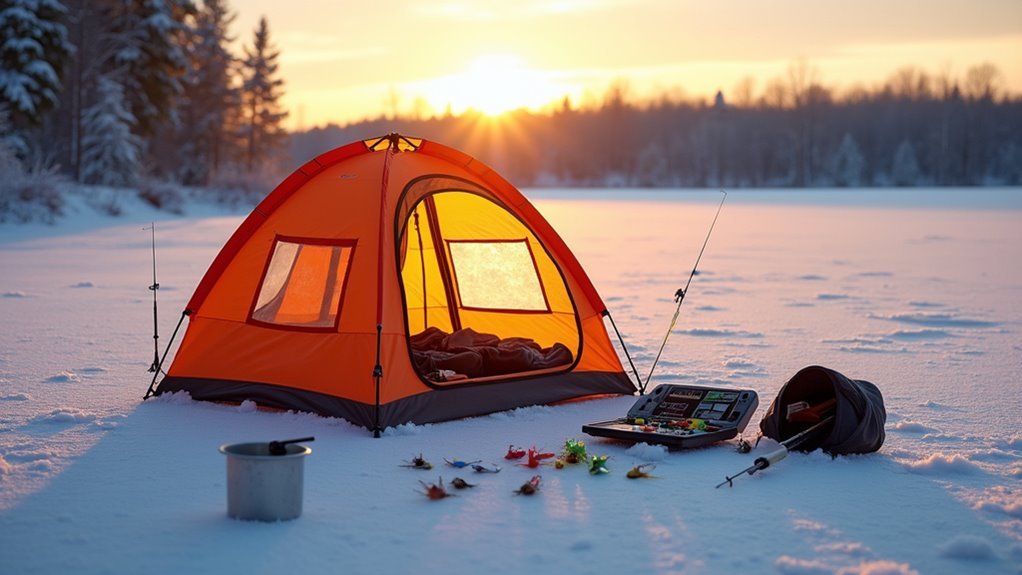
With our understanding of bass behavior on the ice established, let’s talk about what’s in our tackle box. We’ve learned through many frigid mornings that specialized gear makes all the difference when targeting winter bass.
Specialized ice fishing gear isn’t just a luxury—it’s the difference between getting skunked and landing trophy winter bass.
- Short, fast-action rods with light power provide the sensitivity needed to detect those subtle winter bites
- Dedicated ice fishing line that resists freezing and maintains flexibility in cold temperatures
- Larger rod guides that minimize ice buildup, especially on those days when you’re constantly pulling fish through the hole
Proven Lures and Jigging Techniques for Winter Bass
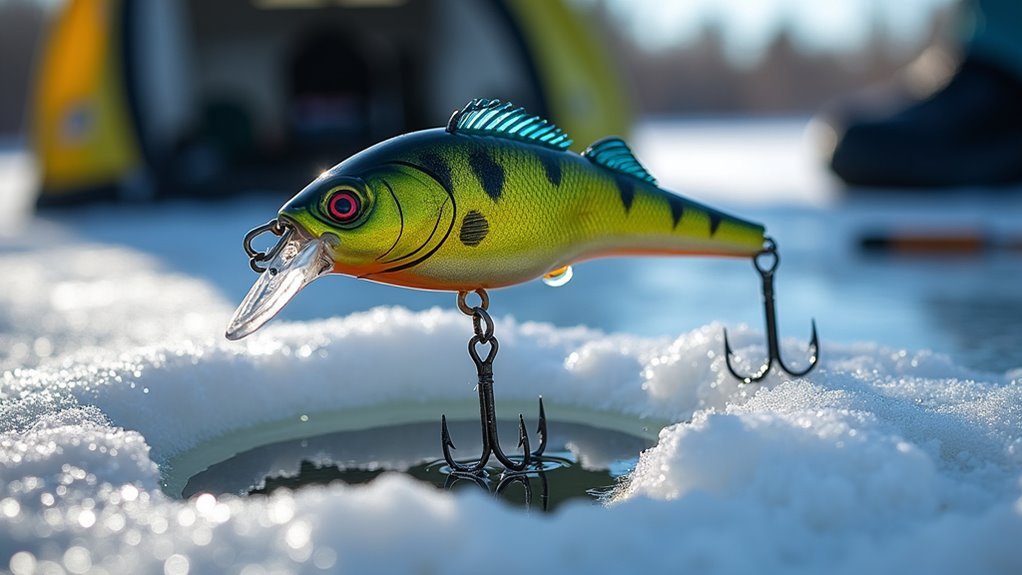
Three essential lure types have proven themselves time and again for ice fishing bass. We’ve had great success with tube jigs and split tail jigs in neutral colors that match local baitfish. Standard jig heads tipped with live maggots or wax worms are deadly when bass get finicky.
The “pop and drop” technique is our go-to method—drop your jig, let it hit bottom, then lift 8-9 inches and repeat. We’ve learned that patience pays off here. When that weight hits your line, give a gentle jerk—don’t yank! Bass aren’t chasing in winter, so slow presentations win the day.
Finding the Best Ice Fishing Locations and Timing
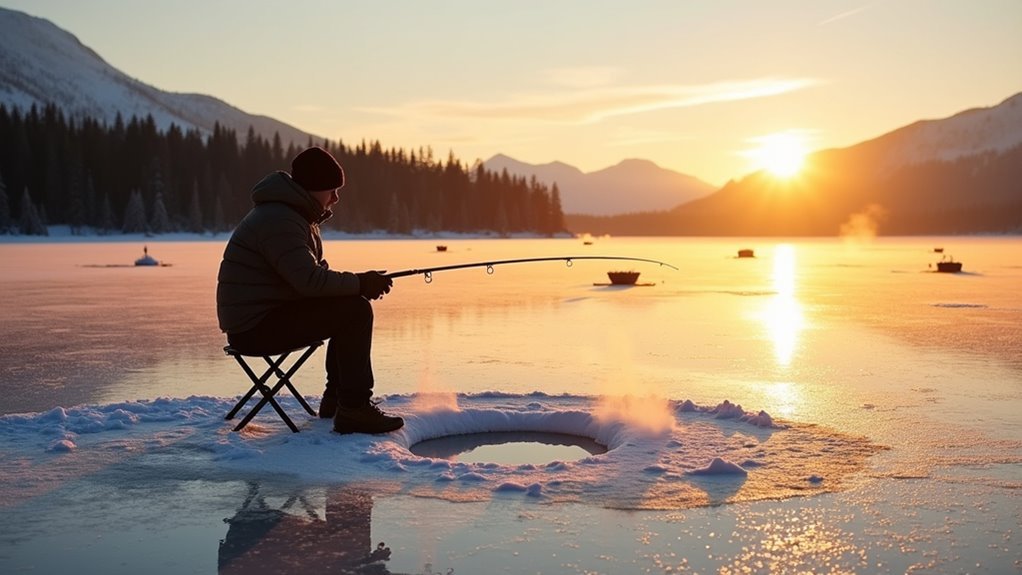
Knowing exactly where to drop your line can make the difference between a successful outing and a frustrating day on the ice. We’ve learned that bass behave differently in winter waters, so timing and location are everything.
- Target deeper areas (25-30 feet) near weed beds for largemouth bass, as these warmer zones attract them during cold months
- Arrive at dawn for peak feeding activity – we’ve caught our biggest bass before 10 AM
- Look for hard structures like rock piles for smallmouth, especially during warm-ups when they move to flats less than 10 feet deep
Adapting Your Strategy to Bass’s Cold Water Habits
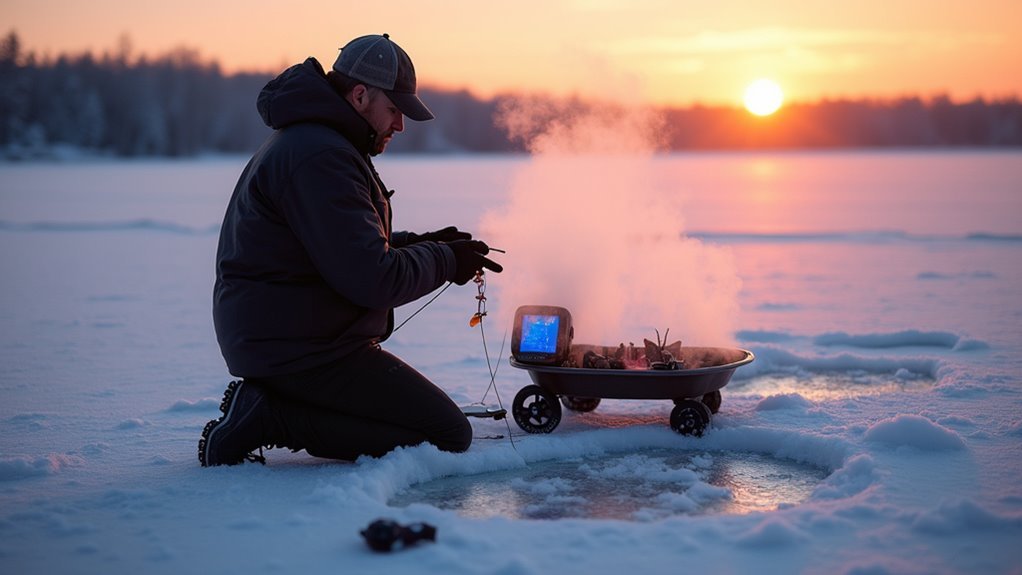
Because bass behave completely differently during winter months, we’ve had to totally rethink our approach to catching them through the ice. These fish aren’t actively chasing prey anymore – they’re conserving energy in deeper, warmer waters.
We’ve found success targeting largemouth around weed beds in 25-foot depths, while smallmouths prefer hard structures like rock piles around 30 feet deep. When temperatures rise near freezing, they’ll move shallower to feed.
The key is slowing everything down. Let your jig sit on the bottom before giving subtle movements. Remember, bass aren’t sprinting for meals in winter – they’re taking their sweet time.
Safely Transporting Your Equipment on the Ice
Getting your gear safely onto the ice is one of those challenges that many fishermen overlook until they’re struggling across a frozen lake. We’ve learned the hard way that a good sled makes all the difference between an enjoyable outing and a frustrating haul.
- A dedicated ice fishing sled with a sturdy rope lets you pull everything in one trip
- Load your tackle box, rods, and all gear together to avoid multiple journeys
- Check local regulations about driving on ice – it’s often prohibited for safety reasons
We’ve found that simple preparation saves energy for what really matters – catching those winter bass!
Frequently Asked Questions
How Do Bass Feeding Patterns Differ by Moon Phase During Ice Fishing?
We haven’t observed consistent moon phase effects on bass feeding during ice fishing. They respond more to warming trends and light levels than lunar cycles when under ice.
Can You Catch Bass at Night Through the Ice?
Yes, we can catch bass at night through ice, though it’s challenging. They’re less active in darkness, so we’ll need glow-in-the-dark lures and extreme patience for these rare nocturnal feeders.
How Does Barometric Pressure Affect Bass Activity Under Ice?
While high pressure drives bass deeper into lethargy, falling pressure activates them under ice. We’ll notice more strikes during pressure drops, but we’re better off waiting out stable high-pressure periods.
What’s the Ideal Ice Thickness for Safe Bass Fishing?
We recommend at least 4 inches of ice for safe bass fishing on foot. For using ATVs, we need 8-12 inches, and vehicles require 12-15 inches of solid ice.
Do Bass Prefer Natural or Artificial Structures During Winter?
We’ve found that bass prefer both natural structures like weed beds and artificial ones like submerged brush piles during winter, though largemouth favor weedy areas while smallmouth seek hard, rocky bottoms.
Conclusion
We’ve shared our ice fishing wisdom, now it’s time for you to hit the ice! Remember, 86% of winter bass are caught in the first and last hours of daylight—timing truly matters. Whether you’re dropping jigs for smallmouth or teasing largemouth from weedy edges, the cold-water bite demands patience. Trust your equipment, read the conditions, and you’ll soon feel that unmistakable thump that makes braving the cold absolutely worthwhile.